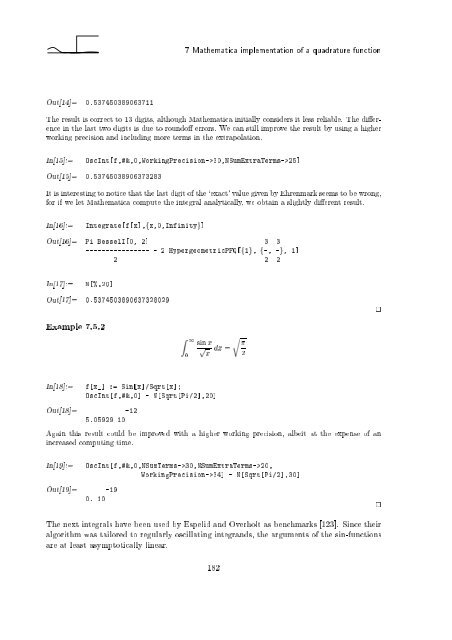Wave Propagation in Linear Media | re-examined
Wave Propagation in Linear Media | re-examined
Wave Propagation in Linear Media | re-examined
You also want an ePaper? Increase the reach of your titles
YUMPU automatically turns print PDFs into web optimized ePapers that Google loves.
Out[14]= 0.537450389063711<br />
7 Mathematica implementation of a quadratu<strong>re</strong> function<br />
The <strong>re</strong>sult is cor<strong>re</strong>ct to 13 digits, although Mathematica <strong>in</strong>itially considers it less <strong>re</strong>liable. The di e<strong>re</strong>nce<br />
<strong>in</strong> the last two digits is due to roundo errors. We can still improve the <strong>re</strong>sult by us<strong>in</strong>g a higher<br />
work<strong>in</strong>g p<strong>re</strong>cision and <strong>in</strong>clud<strong>in</strong>g mo<strong>re</strong> terms <strong>in</strong> the extrapolation.<br />
In[15]:= OscInt[f,#&,0,Work<strong>in</strong>gP<strong>re</strong>cision->30,NSumExtraTerms->25]<br />
Out[15]= 0.53745038906373283<br />
It is <strong>in</strong>te<strong>re</strong>st<strong>in</strong>g to notice that the last digit of the `exact' value given by Eh<strong>re</strong>nmark seems to be wrong,<br />
for if we let Mathematica compute the <strong>in</strong>tegral analytically, we obta<strong>in</strong> a slightly di e<strong>re</strong>nt <strong>re</strong>sult.<br />
In[16]:= Integrate[f[x],fx,0,Inf<strong>in</strong>ityg]<br />
Out[16]= Pi BesselI[0, 2] 3 3<br />
---------------- - 2 HypergeometricPFQ[f1g, f-, -g, 1]<br />
2 2 2<br />
In[17]:= N[%,20]<br />
Out[17]= 0.5374503890637328029<br />
Example 7.5.2<br />
Z 1<br />
In[18]:= f[x_] := S<strong>in</strong>[x]/Sqrt[x];<br />
OscInt[f,#&,0] - N[Sqrt[Pi/2],20]<br />
Out[18]= -12<br />
5.05929 10<br />
0<br />
r<br />
s<strong>in</strong> x<br />
p dx =<br />
x 2<br />
Aga<strong>in</strong> this <strong>re</strong>sult could be improved with a higher work<strong>in</strong>g p<strong>re</strong>cision, albeit at the expense of an<br />
<strong>in</strong>c<strong>re</strong>ased comput<strong>in</strong>g time.<br />
In[19]:= OscInt[f,#&,0,NSumTerms->30,NSumExtraTerms->20,<br />
Work<strong>in</strong>gP<strong>re</strong>cision->34] - N[Sqrt[Pi/2],30]<br />
Out[19]= -19<br />
0. 10<br />
The next <strong>in</strong>tegrals have been used by Espelid and Overholt as benchmarks [123]. S<strong>in</strong>ce their<br />
algorithm was tailo<strong>re</strong>d to <strong>re</strong>gularly oscillat<strong>in</strong>g <strong>in</strong>tegrands, the arguments of the s<strong>in</strong>-functions<br />
a<strong>re</strong> at least asymptotically l<strong>in</strong>ear.<br />
182












